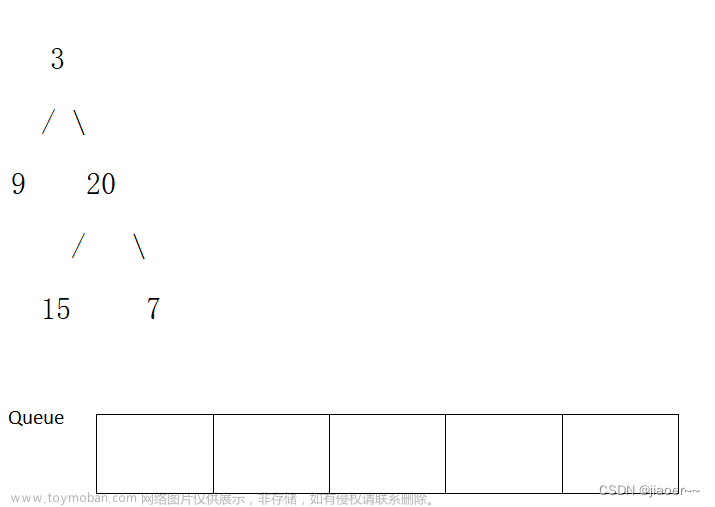1、重建二叉树:
输入某二叉树的前序遍历和中序遍历的结果,请重建出该二叉树。假设输入的前序遍历和中序遍历的结果中都不含重复的数字。例如输入前序遍历序列{1,2,4,7,3,5,6,8}和中序遍历序列{4,7,2,1,5,3,8,6},则重建二叉树并返回。
2、树的子结构:
输入两棵二叉树A和B,判断B是不是A的子结构。如图:A中有一部分子树的结构和B是一样的,因此B是A的子结构
#include<stdio.h>
using namespace std;
struct Node
{
int value;//根节点
BinaryTreeNode* m_pLeft;//左孩子
BinaryTreeNode* m_pRight;//右孩子
}
//判断二叉树A是否包含二叉树B
//1->A;2->B
bool DoseTree1HaveTree2(BinaryTreeNode* pRoot1, BinaryTreeNode* pRoot2)
{
//如果二叉树B节点全部遍历完,返回false
if(pRoot2 == NULL)
return false;
//如果遍历完二叉树A的全部结点,并且二叉树2未遍历结束,返回false
if(pRoot1 == NULL)
return false;
//如果遍历过程中有二叉树的结点不相同,遍历结束,返回false
if(pRoot1->value != pRoot2->value)
return false;
//递归遍历二叉树的所有左右子树
return DoseTree1HaveTree2(pRoot1->m_pLeft, pRoot2->m_pLeft)&&
DoseTree1HaveTree2(pRoot1->m_pRight, pRoot2->m_pRight);
}
//判断两棵树的根结点是否相同
bool HasSubtree(BinaryTreeNode* pRoot1, BinaryTreeNode* pRoot2)
{
bool result = false;
if(pRoot1 != NULL && pRoot2 != NULL)
{
//如果两个根节点相同,就是找到了
if(pRoot1 ->value == pRoot2 ->value)
result = DoseTree1HaveTree2(pRoot1,pRoot2);
//如果未找到,则从左子树开始寻找
if(!result)
return = HasSubtree(pRoot1->m_pRight,pRoot2);
//如果未找到,从右子树中查找
if (!result)
result = HasSubtree(pRoot1->m_pRight, pRoot2);
}
return result;
}3、二叉树的镜像
请完成一个函数,输入一个二叉树,该函数输出它的镜像。如图,右边的二叉树就是左边的树的镜像。

#include <iostream>
struct BinaryTreeNode
{
int m_nValue;
BinaryTreeNode* m_pLeft;
BinaryTreeNode* m_pRight;
};
// 生成二叉树镜像
void MirrorRecursively (BinaryTreeNode *pNode)
{
// 如果结点为空,停止递归
if (pNode == nullptr)
return;
// 交换左右子树
std::swap(pNode->m_pLeft,pNode->m_pRight);
// 当左子树非空时,递归生成左子树镜像
if (pNode->m_pLeft)
MirrorRecursively(pNode->m_pLeft);
// 当右子树非空时,递归生成右子树镜像
if (pNode->m_pRight)
MirrorRecursively(pNode->m_pRight);
}
int main()
{
return EXIT_SUCCESS;
}
4、从上往下打印二叉树
从上往下打印出二叉树的每个结点,同一层的结点按照从左到右的顺序打印。
#include <iostream>
#include <queue>
using namespace std;
struct BinaryTreeNode
{
int value;
BinaryTreeNode*m_pLeft;
BinaryTreeNode*m_pRight;
};
//从上往下打印
void PrintTree(BinaryTreeNode *pTreeRoot)
{
if(pTreeRoot != NULL)
return;
queue<BinaryTreeNode *> queNode;
queNode.push(pTreeRoot);
while (!queNode.empty())
{
BinaryTreeNode *pNode =queNode.front();
queNode.pop();
cout << pNode->value << " ";
if (pNode->p_left)
queNode.push(pNode->p_left);
if (pNode->p_right)
queNode.push(pNode->p_right);
}
}
int main()
{
queue<BinaryTreeNode>data;
BinaryTreeNode n1{5, nullptr, nullptr};
BinaryTreeNode n2{7, nullptr, nullptr};
BinaryTreeNode n3{9, nullptr, nullptr};
BinaryTreeNode n4{11, nullptr, nullptr};
BinaryTreeNode n5{6, &n1, &n2};
BinaryTreeNode n6{10, &n3, &n4};
BinaryTreeNode n7{8, &n5, &n6};
PrintTree(&n7);
return EXIT_SUCCESS;
}5、二叉搜索树的后序遍历序列
输入一个整数数组,判断该数组是不是某二叉搜索树的后序遍历的结果。假设输入的数组的任意两个数字都互不相同
#include <iostream>
#include <queue>
using namespace std;
bool VerifySequenceOfBST(int sequence[], int length)
{
if(sequence == NULL || length <= 0)
return false;
int root = length - 1;
int i = 0;
for(;i<length-1;++i)
{
if(sequence[i] > root)
break;
}
int j = i;
for(;j<length-1;++j)
{
if(sequence[j] < root)
return false;
}
//只有当两个结点都为真才可以
bool left = true;
if (i > 0)
left = VerifySequenceOfBST(sequence, i);
bool right = true;
if (i < length - 1)
right = VerifySequenceOfBST(sequence + i, length - i - 1);
return (left && right);
}
int main()
{
int binary_sort_tree[] = {5,7,6,9,11,10,8};
cout << "The result is "
<< VerifySequenceOfBST(binary_sort_tree, sizeof(binary_sort_tree)/ sizeof(int)) << endl;
return EXIT_SUCCESS;
}6、二叉树中和为某一值的路径
class Soultion
{
puclic:
vector<vector<int>>result;
vector<int>tmp;
vector<vector<int> > FindPath(TreeNode* root,int sum)
{
if(root == NULL)
return NULL;
tmp.push_back(root->val);
if(root->left == NULL && root->right && sum->root->val ==0)
result.push_back(tmp);
//如果不是父节点就是子节点
FindPath(root->left,sum->root->val);
FindPath(root->right,sum->root->val);
if(tmp.size()>0)
temp.pop_back();
return result;
}
};
7、二叉搜索树与双向链表
8、二叉树的深度
输入一棵二叉树的根结点,求该树的深度
思路:如果一棵树只有一个结点,它的深度为1。如果根结点只有左子树,那么树的深度应该是该其左子树的深度加1;同样如果根结点只有右子树而没有左子树,那么树的深度是其右子树的深度加1。如果既有右子树又有左子树,那该树的深度就是其左、右子树的深度较大值再加1。
头文件:
#include <iostream>
using namespace std;
struct BinaryTreeNode
{
int m_nValue;
BinaryTreeNode* m_pLeft;
BinaryTreeNode* m_pRight;
};算法内容:
int TreeDepth(BinaryTreeNode* pRoot)
{
if(pRoot == NULL)
return;
int nLeft = TreeDepth(pRoot->m_pLeft);
int nRight = TreeDepth(pRoot->m_pRight);
return (nLeft > nRight) ? (nLeft + 1) : (nRight + 1);
}主函数:
int main()
{
BinaryTreeNode n8{8, nullptr, nullptr};
BinaryTreeNode n7{7, nullptr, nullptr};
BinaryTreeNode n6{6, nullptr, nullptr};
BinaryTreeNode n5{5, nullptr, nullptr};
BinaryTreeNode n4{4, &n8, nullptr};
BinaryTreeNode n3{3, &n6, &n7};
BinaryTreeNode n2{2, &n4, &n5};
BinaryTreeNode n1{1, &n2, &n3};
int depth = 0;
cout << "The depth is: " << TreeDepth(&n1) << endl
<< "Is a Balance Tree ? : " << IsBalanced(&n1, &depth) << endl;
return 0;
}
9、平衡二叉树
题目:输入一棵二叉树,判断该二叉树是否是平衡二叉树
思想:如果某二叉树中任意节点的左右子树的深度相差不超过1,那么它就是一棵平衡二叉树。
class Solution
{
public:
bool IsBalanced_Solution(TreeNode* pRoot)
{
if(pRoot == NULL)
return true;
int depth = 0;
return IsBalanced(pRoot, &depth);
}
private:
bool IsBalanced(TreeNode *pRoot, int *depth)
{
if(pRoot == NULL)
{
*depth =0;
return true;
}
int left,right;
if(IsBalanced(pRoot->left, &left) && IsBalanced(pRoot->right, &right))
{
int diff = left - right;
if(diff <= 1 && diff >= -1)
{
*depth = left>right?(left+1):(right+1);
return true;
}
}
return false;
}
};10、二叉树的下一个结点
*/
/*分析二叉树的下一个节点,一共有以下情况:
1.二叉树为空,则返回空;
2.节点右孩子存在,则设置一个指针从该节点的右孩子出发,一直沿着指向左子结点的指针找到的叶子节点即为下一个节点;
3.节点不是根节点。如果该节点是其父节点的左孩子,则返回父节点;否则继续向上遍历其父节点的父节点,重复之前的判断,返回结果*/
class Solution {
public:
TreeLinkNode* GetNext(TreeLinkNode* pNode)
{
if(pNode==NULL)
return NULL;
if(pNode->right!=NULL){
pNode = pNode->right;
while(pNode->left){
pNode = pNode->left;
}
return pNode;
}
while(pNode->next!=NULL){
TreeLinkNode* proot = pNode->next;
if(proot->left == pNode)
return proot;
pNode=pNode->next;
}
return NULL;
}
};11、对称的二叉树
题目:请实现一个函数,用来判断一颗二叉树是不是对称的。注意,如果一个二叉树同此二叉树的镜像是同样的,定义其为对称的
思路:递归判断:R1->left与R2->right比较,R2->left与R1->right比较文章来源:https://www.toymoban.com/news/detail-410915.html
struct TreeNode
{
int val;
struct TreeNode *left;
struct TreeNode *right;
TreeNode(int x) :
val(x), left(NULL), right(NULL) {
}
};
class Solution
{
public:
bool isSymmetrical(TreeNode* pRoot)
{
return isSymmetrical(pRoot,pRoot);
}
private:
bool isSymmetrical(TreeNode *pRoot1, TreeNode *pRoot2)
{
if(pRoot1 == NULL && pRoot2 == NULL)
{
return true;
}
if(pRoot1 == NULL || pRoot2 == NULL)
{
return false;
}
if(pRoot1->val != pRoot2->val)
{
return false;
}
return isSymmetrical(pRoot->left, &right) && isSymmetrical(pRoot->right,&left);
}
};12、按之字形顺序打印二叉树
请实现一个函数按照之字形打印二叉树,即第一行按照从左到右的顺序打印,第二层按照从右至左的顺序打印,第三行按照从左到右的顺序打印,其他行以此类推。文章来源地址https://www.toymoban.com/news/detail-410915.html
13、把二叉树打印成多行
struct TreeNode
{
int val;
struct TreeNode*left;
struct TreeNode*right;
TreeNode(int x):val(x),left(NULL),right(NULL);
{}
};
class Solution
{
public:
vector<vector<int> > Print(TreeNode* pRoot)
{
vector<vector<int>>ans;
if(pRoot == NULL)
return ans;
queue<TreeNode*>q;
q.push(pRoot);
while(q.empty())
{
int size = q.size();//读取每一层的元素的数量
vector<TreeNode*>q1;
while(size--)
{
TreeNode*front = q.front();
q.pop();
q1.push_back(front ->val);
if(front->left!=NULL) return front->left;
if(front->right!=NULL) return front->right;
}
ans.push_back(q1);
}
return ans;
}
};14、序列化二叉树
15、二叉搜索树的第k个结点
//中序遍历
TreeNode* KthNode(TreeNode* pRoot, unsigned int k)
{
TreeNode *cur = root;
int count = 0;
stack<TreeNode*>s;
while(s.empty() || cur)
{
if(cur != NULL)
{
s.push(cur);
cur = cur->left;
}
else
{
cur = s.top();
s.pop();
count++;
if(num == k)
return cur->val;
cur = cur->right;
}
}
return 0;
}到了这里,关于剑指offer:关于二叉树的汇总(c++)的文章就介绍完了。如果您还想了解更多内容,请在右上角搜索TOY模板网以前的文章或继续浏览下面的相关文章,希望大家以后多多支持TOY模板网!












